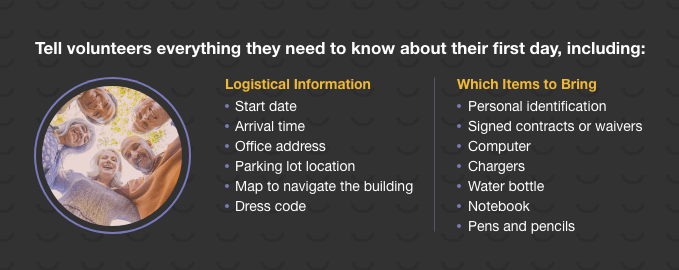After recruiting volunteers, you can integrate them into your organization through volunteer onboarding. The onboarding process allows volunteers to learn more about their place in your organization.
Onboarding volunteers is more than teaching the policies and procedures — it is a strategy to ensure your volunteers remain committed to the mission. With an onboarding process, your organization can get the most return from its volunteer recruitment efforts.
What Is Volunteer Onboarding?
Volunteer onboarding is the process of integrating volunteers into your organization. This part of volunteer management is how volunteers learn the skills and knowledge needed to have a successful experience.
While orientation is a one-time meeting to acclimate volunteers to their role, onboarding goes beyond this. The onboarding process makes sure your volunteers’ work will benefit both themselves and your organization.
With volunteer onboarding, the volunteers can:
- Learn more about your organization’s culture.
- Bond with other volunteers.
- Get placed in a role.
- Be trained in their responsibilities.
- Receive needed tools and resources.
- Feel committed to your cause.
Why Creating a Seamless Volunteer Onboarding Process Matters
New volunteers must believe they can learn their role and do it well. Onboarding volunteers is critical for letting them know they are welcome in your organization and will be supported. The onboarding experience also captures volunteers when they are most motivated to get them excited about their role.
When your volunteer organization invests in volunteer onboarding, you can increase the return on your investment in your volunteers. The process creates engaged and prepared volunteers ready to help your mission.
A seamless onboarding process helps to foster:
- Better engaged volunteers: Sharing your program’s goals can help volunteers understand how their work fits in and how their skills and talents can support the mission. When volunteers understand that their work matters, they’ll feel more engaged.
- Interpersonal relationships: Your volunteers will commit to your volunteer organization when they feel connected. Encouraging interpersonal connections through socializing opportunities, team-building exercises, mentoring, and more can help new volunteers feel like a part of your mission.
- Awareness of the organization’s goals and values: Volunteer onboarding tells volunteers more about your mission and values. Volunteers can also learn how their role contributes to the organization’s goals. New volunteers can use this information to educate themselves and others about your organization.
- Early training support: Supporting your volunteers during training will help them understand their role and take responsibility for their learning. You can acclimate your volunteers to their role a little at a time, so they feel prepared on their first day.
Volunteer Onboarding Checklist
Follow this 10-step volunteer onboarding template to set up an effective onboarding process in your organization.
1. Understand Each Volunteer’s Background
Since every volunteer has a unique history, each volunteer needs different encouragement to remain involved with your organization. For example, some volunteers have a family member or friend who is a beneficiary of your organization. You can invest fewer resources in their orientation and training because they already understand your mission’s impact.
Volunteers who need service credit for school may only want to work for your organization until they’ve gained the hours they need. By giving these individuals valuable skills and opportunities, they can better understand your mission. These positive outcomes of the volunteer experience may encourage short-term volunteers to support your organization long-term.
2. Orient Your Volunteers to Your Organization
Help your volunteers understand your organization by providing this key information:
- History of the organization: The history tells why your organization was founded, which can interest or inspire volunteers to feel like part of your story.
- Values and mission: Your mission explains your purpose and how you’re striving to achieve your goals.
- Leadership structure: Organizational charts explaining how the various roles are connected tells volunteers where to direct their questions.
- Roles and teams in the organization: A list of volunteer opportunities can encourage volunteers to choose a role that aligns with their interests as well as potentially recruit their friends.
When volunteers understand the values and impact of your organization, they can identify how to further these goals in their work. This information may encourage them to become long-term supporters.
3. Train Your Volunteers on Their Role and Responsibilities
Training teaches the volunteer what they will do in their role. Training can include:
- Videos or webinars to explain volunteer activities
- Observation of volunteers and staff to see the work in action
- Q&A sessions to give volunteers an opportunity to get more information
- Quizzes and tests to verify their understanding
4. Set Up Technical Tools
For volunteer roles needing technology access, set up these tools before their first day. Make sure to:
- Create an email account.
- Share PowerPoint presentations and other files.
- Share the organization’s calendar.
- Set up access to collaborative tools like Google Drive or SharePoint.
5. Communicate the Details About the Volunteer Event Early

Tell volunteers everything they need to know about their first day. Sharing this information helps the volunteer feel prepared and demonstrates that your organization is organized. Send them logistical information like:
- Start date
- Arrival time
- Office address
- Parking lot location
- Map to navigate the building
- Dress code
You should also tell them which items to bring, including:
- Personal identification
- Signed contracts or waivers
- Computer
- Chargers
- Water bottle
- Notebook
- Pens and pencils
6. Host Social Events for Volunteers
Create opportunities for new volunteers to get to know the staff and other volunteers. The socialization helps them build meaningful connections and feel like part of your organization. Plus, making new friends is a perk of volunteering. Some social event ideas include brunches, team-building events, and mentorship programs.
7. Evaluate Your Volunteers’ Progress
Evaluation encourages volunteers to work for your organization long-term and helps you get the most value from your volunteer team. Evaluation ideas include:
- One-on-one meetings: Meet with each volunteer regularly to discuss their impact on the organization. The volunteers will appreciate the praise.
- Leadership opportunities: Encourage volunteers to increase their contribution by telling them about other volunteer opportunities.
8. Show Your Volunteers Your Appreciation
Since your volunteers give their time and efforts to your cause, show them you appreciate their work. A volunteer recognition program can acknowledge volunteers with:
- A personal thank you
- A card or email
- Public recognition of their work
- A volunteer-of-the-month program
- A reward system
9. Ask for Feedback
When the volunteer event is over, ask volunteers for feedback about their experience with your volunteer organization. Be open to their points of view and comments. Their insights can help you improve your onboarding program and make other changes.
10. Keep Internal Notes About Your Volunteers
Track each volunteer’s progress throughout the onboarding process in a volunteer database. Your organization can collect valuable information for volunteer management, reviews, and grant applications.
Keep note of the following data:
- Number of people the volunteers serve
- Monetary value of the volunteer work
- Number of active volunteers
- Volunteer hours
- Number of return volunteers
With volunteer management software like Volgistics, you can set up which service values to track.

Onboarding Volunteers is Seamless with Volgistics
Your organization can create a positive and successful volunteer onboarding experience with Volgistics software that manages volunteers through the volunteer cycle. Organize your volunteer data to manage the onboarding process and encourage loyal, long-term volunteers.
Volunteer management software helps organizations keep track of:
See how Volgistics can benefit your organization’s onboarding efforts. Sign up for a free 30-day trial or schedule a live demonstration. For more information about volunteer onboarding tools, contact us.

